A Week with the Paradise Orchestra
One day in May 2014, I opened my email and saw a message from Brian Shillito, an old friend with whom I had worked and roomed in London (Ontario) almost forty years ago. (Brian participated in an online discussion on this site a few years ago.) Brian is a New Zealander and has been the assistant principal violist (“sub-principal,” in local parlance) of the New Zealand Symphony Orchestra for the past few decades, after having done what New Zealanders call his “OE” (Overseas Experience); studying in the US for a couple of years, working in Canada for three years, and then freelancing in the real London before returning home.
Brian asked if I might have any interest in coming to New Zealand as guest principal violist for the last two weeks of July, as their principal would be on maternity leave for much of their winter subscription season. I tried not to hurt myself in my hurry to respond. He passed my response on to NZSO management, and in a couple of days I had received from the NZSO via email 1) a contract, 2) the necessary documents to apply for a work visa (including approval of my application by the Service and Food Workers Union Nga Ringa Tota – English and Maori are both official languages in New Zealand), and 3) all the music in .pdf format. After figuring out that the New Zealand consulate required photos of a different size than do US passport applications, and finding a place that could actually produce photos in that size (the only part of the whole process that even approached being challenging; no one in Milwaukee seemed able to do it), I sent my application in to the NZ Immigration website. It was approved in a day or so and sent to me electronically. At the same time, I was working out flights with the NZSO travel manager, Brian Morris.
(I should add, at this point, that all of the NZSO staffers I dealt with were friendly, helpful, and extremely responsive to my questions and requests. These included, in addition to Brian Morris, Tjasa Dykes, NZSO Artistic Schedule Coordinator, Janina Hanify, NZSO Publicity and Communications Manager, Michelle Lewis, NZSO Orchestra Management Coordinator, Sarah Marten, NZSO Assistant Librarian, Garry Smith, NZSO Concerts Manager, Mable Wong, NZSO Principal Librarian, and Sarah Glasgow. I’m sure they have lots of practice importing foreigners, but I doubt any American orchestra could have done as well or moved as quickly. Having a government that doesn’t regard immigration as a national security threat no doubt helps.)
My biggest concern about traveling was my bow. Like most bows, mine had some ivory on the tip. Given the complete fustercluck currently surrounding the enforcement of the US ban on importing ivory, I was not about to take any risk of having my bow confiscated by Customs upon my return. So I contacted Roger Zabinski in Minneapolis, who had made the bow for me in 1985. He coached me on how to ship the bow to him via FedEx (PVC tube mixed with bubble wrap is the magic sauce, it seems), and replaced the ivory with silver. So I didn’t apply for an instrument passport (which I’m not sure that the bow would have qualified for in any case, given when it was made). And, of course, I left my beautiful old French bow at home for the same reasons, much as I would have liked to show it off. (As it happened, no one showed the least interest in me, my bow, or my instrument upon my return to the US at San Francisco International when I did come back from New Zealand. Go figure.)
Rehearsals started Monday, July 21. New Zealand is 17 hours ahead of Milwaukee in July (and thus across the International Date Line), so in order to get there on Saturday and give myself some time to recover, I needed to leave the Thursday before. A 2:00 PM bus to O’Hare, a full flight to LAX (and nearly not getting my instrument on the plane), and walking across the 82 lanes of traffic at LAX that separate the United terminal from the international terminal got me to Air New Zealand already feeling I’d had a very full and tedious day.
Air New Zealand gave me a wonderful night ride across the Pacific in a brand-new 777-300ER. And it is literally “across the Pacific”; except for one mile of Los Angeles and a few miles of Auckland, the entire 12-hour flight is over water. I had legroom, two very edible meals, a wonderful iPhone-compatible inflight entertainment system, and noise-canceling headphones I’d bought in honor of the occasion, which made a huge difference in terms of comfort and overall stress levels. (They were Bose QuietComfort®25 cans, for any geeks reading; much better-sounding than earlier Bose attempts.)
The flight arrived in Auckland at sunrise. Auckland airport has to be one of the most intimate and passenger-friendly international hubs on the planet, and immigration/customs was a breeze. It was, in fact, all electronic; after putting my passport in the machine, the only human interaction I had was when they x-rayed my bag after going through customs. The reason? New Zealand is very strict about protecting its unique ecosystems, and they worry a great deal about invasive species. Fortunately for me and the NZSO, violists aren’t on the list of proscribed species. They must not know the joke about what happens when a viola is left in the back seat of a car in New York City.
Unfortunately, the connection was tight, the flight was late to the gate, and my bag took a while to get to me. By the time it did, I’d missed my connecting flight to Wellington. Worse, I had neglected to transfer Brian’s phone number from my email to my address book, so I had no way to call him to let him know I’d be late and so not to pick me up at the airport. But it all worked out, and I had my first of several jaw-droppingly scenic flights over New Zealand three hours later.
Once at Wellington airport, I got some New Zealand currency from the ATM and took a cab to where I was staying. The orchestra had booked me into a studio apartment about 10 minutes walk from the hall, which was basic but pleasant. Brian called shortly after I got there and we made arrangements for dinner that night, to which he was also inviting the orchestra’s principal violist, Julia Joyce (who, as mentioned above, was on maternity leave but still very pregnant), and her husband Andrew, who is the orchestra’s principal cellist and was on a corresponding paternity leave. (His substitute was Jonathan Ayling, assistant principal cellist of the Royal Philharmonic and a wonderful player and colleague.) On the way to Brian’s house, we did some sightseeing, driving around Wellington and stopping to get a few pictures. It was a typical Wellington winter day; wet and windy. As beautiful as the landscape was, I was most impressed by the sight of people windsurfing in a near-freezing gale. They grow hardy folk down there.
It was a lovely dinner party. We talked about all the things one would expect us to talk about, including stand partners we had known and loved, or otherwise, I waxed eloquent about my favorite stand partner, Evelina Chao, with whom I shared the first desk in the Saint Paul Chamber Orchestra for 6 years. After Julia had her baby, she let me know that Evalina was a name they’d been considering, and I had convinced them (without knowing I was doing so, of course) to settle on it. So it was a fairly consequential dinner for a few people at least.
Sometime in the middle of the night. lying awake in bed 7 time zones behind where my pineal gland thought I was, I felt the building shudder. “I didn’t know I was this close to a rail line,” I thought – until I realized the shuddering was side to side and there was no engine noise. “An earthquake,” I thought next. Sure enough, I checked the website that reports on seismic activity in New Zealand; there had been a 4.0 quake in the middle of the Cook Strait about 20 miles to the south. There are a lot of earthquakes in New Zealand.
The next day, I went sightseeing on my own. Wellington is a wonderful city for walkers. My hotel was about 10 minutes walk from the hall, which is on the waterfront. Between me and the hall was Cuba Street, a pedestrian mall hard to describe to anyone who doesn’t know State Street in Madison. It’s very university town-ish; lots of old buildings and young people, inexpensive places to eat ethnic food, used book stores, used record stores, outdoor clothing stores – and one store that sold and serviced lawnmowers. I had a lovely breakfast (New Zealand does very good breakfasts) and walked down to the waterfront, which is spectacular. I took the cable car up to the Botanical Gardens and even more spectacular views. I was beginning to realize that “spectacular” is redundant when applied to “view” in New Zealand; the entire country is of a hallucinogenic beauty. I don’t know if heaven looks like New Zealand, but I’ll bet Eden did.
After I got back to Milwaukee, I spent some time contemplating just why I found New Zealand so physically attractive. Part of it is that it is a very large country with a very small population; just slightly smaller than Japan and Italy in area but, with a total population of only 4.5 million, one of the least-densely populated countries on earth. What’s more, unlike other low-density countries like Australia, Canada, and Russia, most of the country is temperate, so most of the landscape that’s not vertical is cultivated in some way, if only for livestock grazing or forestry. That by itself makes for an attractive landscape.
New Zealand also has an immensely long coastline, much of which is quite dramatic. This is a problem for sailors, as harbors are few and far between. But for aficionados of landscapes, it’s glorious.
Eventually I realized that much of the attraction of the landscape for me was that it was so similar to that of California, where I grew up. This is not surprising; it was formed by the same mechanism of plate tectonics as was California and Japan (which also looks rather Californian in terms of shapes). Unlike California, however, most of New Zealand is verdant and not Mediterranean; green rather than golden brown.
But it wasn’t just the scenery. The country seems to embody the best aspects of life in both those countries colonized by the English and the northern European social-welfare model societies. There is very little visible poverty; everyone seems well-dressed and well-fed. While there are differences in housing quality, and some parts of Wellington looked more prosperous than others, I never saw anything that looked remotely like the inner cities of most American 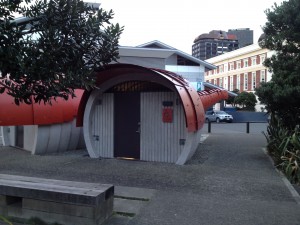 cities. People were uniformly polite and helpful, although of course most of those I met outside of the orchestra were in the hospitality and travel business. Everything “worked” (except for the wi-fi at my hotel, which worked only some of the time). And there was considerable understated humor, both private and public. One of the sights on my way to and from the hall was a famously whimsical fountain, where one of the leads in Lord of the Rings (which was, of course, shot in New Zealand) was supposed to have done something fountain-ish he oughtn’t to have done in public. Another was this public toilet on the Wellington waterfront. And my favorite was something I
cities. People were uniformly polite and helpful, although of course most of those I met outside of the orchestra were in the hospitality and travel business. Everything “worked” (except for the wi-fi at my hotel, which worked only some of the time). And there was considerable understated humor, both private and public. One of the sights on my way to and from the hall was a famously whimsical fountain, where one of the leads in Lord of the Rings (which was, of course, shot in New Zealand) was supposed to have done something fountain-ish he oughtn’t to have done in public. Another was this public toilet on the Wellington waterfront. And my favorite was something I 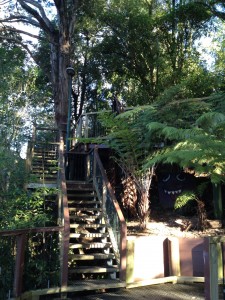 discovered on a walk along the river in the small city of Hamilton; a joke clearly intended for residents, as Hamilton is not a tourist destination. (Look closely in the cave on the right.)
discovered on a walk along the river in the small city of Hamilton; a joke clearly intended for residents, as Hamilton is not a tourist destination. (Look closely in the cave on the right.)
By the end of my two weeks, I was trying to figure out ways that I could come back and live there, at least part of the year. No doubt a fantasy, but it is the kind of place that gives rise to fantasies like that. I’m sure that there are bad people in New Zealand, and heartbreak and struggle and all the other ills to which people can fall prey. But it seemed closer to heaven on earth than anyplace I’d ever been before.
We started work on Monday. The orchestra has an intriguing and unusual subscription concert model. Programs are rehearsed for a few days in Wellington and then immediately taken on the road, with the one Wellington concert placed at the end of the tour. Luckily for me, the two weeks I was there was one of the season’s more extensive tours. In addition to the subscription concert, which we would play in Hamilton, Auckland, Christchurch, Dunedin, and finally in Wellington, the orchestra was also playing for the Lexus Song Quest competition in Auckland, which involved an additional three rehearsals in addition to the concert with the finalists.
We had five rehearsals on the subscription program and one on the Song Quest repertoire over the Monday-Wednesday period. It all felt very normal, except of course for the fact I only knew one person in the orchestra personally and another (Phillip Rose, about whom more later) via email. Rehearsals were from 9:30 – 12:00 and 1:00 – 3:30, but there were many places to eat very close to the hall, so eating out at lunch was not a problem.
One aspect of the NZSO workplace I found fascinating (and which I would come to understand better once I saw Christchurch) was that every service in a new venue (including the home venue in Wellington) began with an announcement by Garry Smith, NZSO Concerts Manager, of where to go and what to do in an emergency; ie fire, evacuation of the hall, and (especially, I suspect) earthquake. Not a bad practice to emulate for American orchestras faced not only with those possibilities, but also such things as tornadoes and terrorism, domestic or foreign.)
The conductor for the subscription set was a young Englishman by the name of Alexander Shelley, who is the new music director of the National Arts Centre Orchestra in Ottawa. It was a very interesting program centered thematically on Shakespeare, and one he obviously knew very well. But only one work was standard repertoire – three pieces from Mendelssohn’s Midsummer Night’s Dream. The other three works were a suite from Korngold’s incidental music for Much Ado about Nothing, Walton’s Henry V suite from the Olivier film, and Strauss’ first tone poem – Macbeth. All of it was challenging, and five rehearsals did not feel like overkill to me. Of course, the fact that I was barely conscious for at least two of them due to jet lag made the schedule seem shorter.
The orchestra’s hall in Wellington, the Michael Fowler Centre, was quite decent – a little dry, but overall a nice sound and 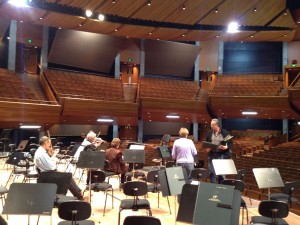 lots of definition onstage. The facilities are far nicer than what I’m used to at home; I’ll describe them later in this article.
lots of definition onstage. The facilities are far nicer than what I’m used to at home; I’ll describe them later in this article.
On one of those evenings, I had another lovely dinner; this time with two of the American expatriate members of the orchestra, violist Phillip Rose and his wife Mable Wong, who is the principal librarian. Both had come to New Zealand after the closure of the New Orleans Symphony. Phillip and I, it turned out, had done many of the same auditions in the US before I came to Milwaukee and he to New Zealand, and also shared a background in computer programming, so we had a lot to talk about.
Our first concert was in Hamilton, which is a small city about 90 minutes drive south of Auckland. Being small, the only flights there from Wellington are on turboprops, so the orchestra was booked on two different flights, for which people would sign up. Not being there to sign up, I was booked on the early flight, which, while less popular with the regular members of the band, was fine with me – day rooms were provided and I got to spend time walking around. The weather was (and remained, for most of my stay in NZ) beautiful.
Hamilton is an odd duck. It appears to be the center of an agricultural district, so it was town-y and rural at the same t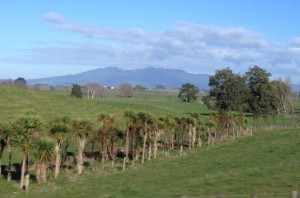 ime. I had a wonderful lunch at a Korean restaurant and a nice walk along the local river. I also bought a belt at Kmart (having left mine behind in Wellington) and experienced my only moment of Schadenfreude on the entire trip when I found it every bit as dimly lit and depressing as Kmarts in the US. Cheap, though.
ime. I had a wonderful lunch at a Korean restaurant and a nice walk along the local river. I also bought a belt at Kmart (having left mine behind in Wellington) and experienced my only moment of Schadenfreude on the entire trip when I found it every bit as dimly lit and depressing as Kmarts in the US. Cheap, though.
The hall in Hamilton was not great (although I was very grateful for the Internet access and the wi-fi password provided by the hall staff, as I got there quite early). The orchestra had a short acoustic rehearsal before the concert, as we did before the others as well, which Alex Shelley used very intelligently and efficiently. And the concert went well, given the novelty of the repertoire and the dry acoustic.
After the concert, the orchestra bundled itself into two buses and drove to Auckland, where we had a first-class hotel. That was the only lon-distance bus trip of the entire tour, but even that was only 90 minutes, and the hotel alone was worth that.
We were two days in Auckland, but we had four services plus an acoustic rehearsal. There was still time for some sightseeing, though. Brian and I spent considerable time on the waterfront, which was about 15 minutes walk from the hotel. Auckland is the center of the New Zealand sailing scene, which is huge – for example, most of the members of the nominally American team defending the America’s Cup in San Francisco in 2014 were Kiwis. There were older America’s Cup boats on display and a museum we didn’t visit. There was also a sailing photography gallery at which I dropped a fair amount of money on two beautiful pictures. (Fortunately I didn’t see the advertisement for the flight school offering 737 simulator sessions to the public until I was on the plane back to Wellington, or I would have dropped a lot more money – and all of my sightseeing time – on that.) I did get to have lunch with the several sailors in the orchestra, though, and hear about what cruising in New Zealand is like. (It’s predictably wonderful, although the absence of harbors along the coasts makes long-distance cruising a challenge.)
The Auckland Town Hall is regarded by members of the orchestra as the best concert hall in the country. It was, according to local legend at least, modeled on the old Gewandhaus in Leipzig (which of course was destroyed by Allied bombing in World War II). It certainly had a very Old World look, and the sound was lovely.
The first Lexus Song Quest was in 1956 and was originally sponsored by Mobil before being taken over by Lexus. It is, in essence, the Kiwi equivalent to the Metropolitan Opera National Council Auditions in the US (one of the first winners was Kiri te Kanawa). The conductor this year was a very charming, quirky and competent opera specialist by the name of Emmanuel Joel-Hornak, who the orchestra warmed up to (or at least I did) after a slightly skeptical first impression. The six finalists were all young and attractive New Zealanders (although some were returning from studies or work overseas for the competition) who all sang well. So it was a more enjoyable evening than I had anticipated. 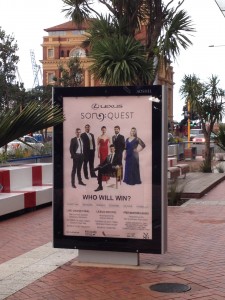 It was a pretty big deal in Auckland, by the way – posters on the streets and a full house, as well as a review – which our subscription concert the next night didn’t appear to get. Of course, Auckland has its own orchestra, and the interaction of local pride and a concert by the official National Orchestra appeared to be rather… complex.
It was a pretty big deal in Auckland, by the way – posters on the streets and a full house, as well as a review – which our subscription concert the next night didn’t appear to get. Of course, Auckland has its own orchestra, and the interaction of local pride and a concert by the official National Orchestra appeared to be rather… complex.
We flew back to Wellington on Sunday morning, with our next service in Christchurch on Wednesday night. The weather was still lovely, so I spent most of the day walking around. There is an old restored cable car from the water to the Botanic Garden, which is on one of the hills overlooking the harbor. As you can see, the view from the top is spectacular. 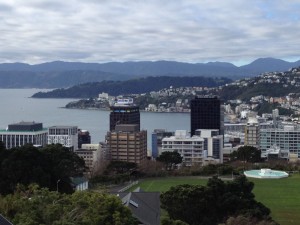 But the Botanic Gardens are worth seeing all on their own. New Zealand works very hard on maintaining and protecting native flora and the look of the place was noticeably different from anything I’d seen at home. Brian and I had dinner that night at one of three (!?) Mexican restaurants within easy walking distance of my hotel, and it was quite good too.
But the Botanic Gardens are worth seeing all on their own. New Zealand works very hard on maintaining and protecting native flora and the look of the place was noticeably different from anything I’d seen at home. Brian and I had dinner that night at one of three (!?) Mexican restaurants within easy walking distance of my hotel, and it was quite good too.
While planning the trip, I had suggested to Brian that we do the TranzAlpine, one of three long-distance passenger trains still running in New Zealand. Being a rail buff, I had hoped to be able to take the train from Auckland to Wellington when I first arrived, but unfortunately it only runs alternate days, and that wasn’t one of them. And the third train, which runs down the east coast of the south island, only runs in the summer.
New Zealand never had much of a train network; partly because of challenging terrain, I suspect, but mostly because of low population density. The three long-distance passenger trains remaining all function more as tourist attractions than as transportation. There are commuter rail systems in Wellington and Auckland, and remnants of others (the famous station in Dunedin, mentioned below, being an example), but even freight rail is limited. Much of the rail in New Zealand was, and is, narrow gauge, due to the the difficulty of constructing right-of-ways in such rugged terrain.
The TranzAlpine is a famously scenic route from Christchurch, on the east coast of the southern island, to Greymouth on the west coast, traversing the Southern Alps on the way. The route only exists today because of coal; there is coal mining in Greymouth, on the west coast, but historic demand and the current export infrastructure are in Christchurch, on the east coast.
Brian, although a native of Christchurch, had never done the TranzAlpine, so he was game. The round trip takes about 11 hours, with enough time for lunch at Greymouth. We flew down to Christchurch on Monday, two days in advance of the orchestra, and stayed the night with Brian’s brother Warwick, who teaches in Christchurch, planning to board the train the next morning.
The train is designed for sight-seeing, with very large windows and one car with wide-open sides instead of windows, intended for photographers and fresh-air aficionadi, Even though it was winter, and quite chilly, that car was consistently crowded.
The trip was every bit as spectacular as advertised. The landscape reminded me of the Highlands of Scotland, writ very large indeed, rather than the Alps, although it was possible to see some more Alpine landscapes off in the distance on occasion.
The route climbs almost 2,500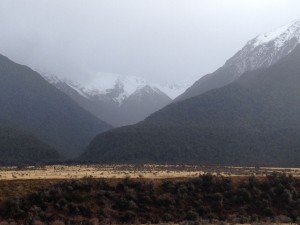 feet to Arthur’s Pass, at which point it goes through a tunnel 5 miles long and begins a steep descent to the west coast. Unfortunately, the tunnel was closed for track maintenance, so the route from Arthur’s Pass to Greymouth was done by bus. This had the advantage of taking us over the very top of the pass, as well as providing a stop at Lake Brunner, which likely seems far less desolate in the summer.
feet to Arthur’s Pass, at which point it goes through a tunnel 5 miles long and begins a steep descent to the west coast. Unfortunately, the tunnel was closed for track maintenance, so the route from Arthur’s Pass to Greymouth was done by bus. This had the advantage of taking us over the very top of the pass, as well as providing a stop at Lake Brunner, which likely seems far less desolate in the summer.
Brian and I had lunch at the old station in Greymouth before boarding the bus for the return trip. We got back to Christchurch around 6 PM, just in time for another lovely meal with Warwick.
The following day the rest of the orchestra flew in to join us in Christchurch. Brian and I drove into town early to visit his mother, whom I’d met decades before when Brian and I lived in Canada. Afterwards, Brian dropped me off at the orchestra hotel; after settling in, I spent most of the afternoon in a long walk around Christchurch.
The 2010 Christchurch earthquake was covered in the US news media, but not to the extent that I had any idea just how bad it had been. I got some idea when I saw another one of the subs while walking around; an Australian who’d played with the orchestra before the earthquake but had not been back to Christchurch since. He was walking around looking gob-smacked; when he saw me, his first words were “it’s all gone!”
What was obvious to me during an afternoon’s walk were the gaping holes in the cityscape; lots of empty lots, although some had construction underway. Many taller buildings still standing were empty, and it didn’t take close observation to note cracks in the structures. The beautiful 19th-century cathedral in the central square had been devastated; the spire had come down and the front of the building had essentially collapsed. Sadly, the church authorities had decided shortly before our visit to demolish what was left. Many of the buildings in the center of town, which were also from the 19th century, had likewise been fatally damaged, and were by this time mostly gone. There were also 10,000 houses and apartments that had been damaged beyond repair (including the house in which Brian had grown up), so there is still a severe housing shortage, which doesn’t look to be resolved any time soon.
The Christchurchers had come up with ingenious short-term solutions to some of the problems. The cathedral had been replaced by a Transitional Cathedral made mostly of cardboard, while I found two small shopping centers constructed out of shipping containers.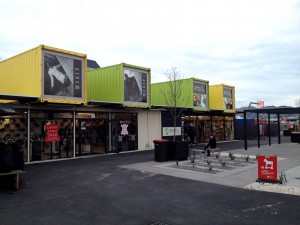
One part of town that had suffered no damage were the famous Botanic Gardens, laid out in a curve of the River Avon. Christchurch is the most English of all New Zealand’s cities, and the gardens were a fine example of English garden landscaping. Even in the depths of winter, they were beautiful. And the attached Canterbury Museum, while small, was worth seeing as well, if only for the Maori viola joke (see picture below).
The Christchurch venue that the NZSO had played in for many years, the Christchurch Town Hall (an architectural predecessor to the Michael Fowler Center in Wellington), had also been damaged by the quake. (I found it surprising that so many modern buildings had been severely damaged; many beyond practical repair. So have many residents of Christchurch.) The orchestra has been using various other venues for their concerts in the past few years. The venue for this concert was one new to the orchestra; the Royal New Zealand Air Force Museum.
After a longish bus ride, we got there around 5:30 PM for an acoustic rehearsal at 6, which left some time to explore. It being winter, and the museum being a barn-like structure, there were some very large and noisy heater/blowers in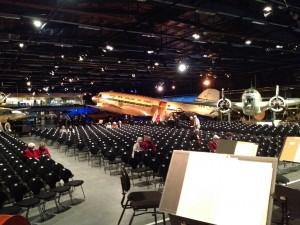 operation, all glowing red and looking very jet-like. Surprisingly, the sound was remarkably good. As you can see, it was a very dramatic space for a concert, and the Henry V suite, being music for what amounted to a WW II British propaganda film, was a good fit. One of the exhibits was the cockpit from a de Havilland Vampire, a very early jet fighter. I might have been the very first person ever to have sat in a Vampire cockpit in tails.
operation, all glowing red and looking very jet-like. Surprisingly, the sound was remarkably good. As you can see, it was a very dramatic space for a concert, and the Henry V suite, being music for what amounted to a WW II British propaganda film, was a good fit. One of the exhibits was the cockpit from a de Havilland Vampire, a very early jet fighter. I might have been the very first person ever to have sat in a Vampire cockpit in tails.
There was a cafeteria at the museum, so I walked through the other part of the building (where there was a Spitfire undergoing restoration) for a pre-concert snack, causing me to almost miss the start of the first piece. There’s either a viola joke or a dumb American joke in there, I’m sure.
I was able to spend some more time walking around Christchurch on Thursday morning, even though we were flying to Dunedin that day. The ease of flying in New Zealand allowed such adventures. Check-in for domestic flights took a maximum of 10 minutes, security checkpoints took almost no time to get through (and turboprop flights had no checkpoints at all), and bags arrived quickly on the other end. The notion that one could have an hour-long flight in the middle of the day and not chew up the entire day in dealing with the associated unpleasantness, while completely alien to me, was very refreshing.
Like most of our shorter flights, the flight from Christchuch to Dunedin was also a turboprop leg, so the orchestra traveled on two separate scheduled flights. I was on the second, which left at 1:15 PM (with a departure from the hotel at 11:45 AM). So I had time for both the Canterbury Museum in Christchurch, where I found the Maori viola joke pictured below, and for walking around Dunedin.
Dunedin was, for some of the early years of the colony’s history, the largest city in New Zealand. “Dunedin” is the Scottish name for Edinburgh; the city was founded by the Free Church of Scotland in 1848 and the city still retains remnants of a Scottish flavor. It is one of only two cities in the world south of the 45th parallel of latitude with a population over 100,000, the other being in Argentina. As a consequence, it has had an important role in the history of Antarctic exploration; the ill-fated Scott Expedition departed from Dunedin in 1912, as well as many others more fortunate. It also hosts the world’s southernmost professional theater company, the Fortune Theatre, as well as a host of choirs.
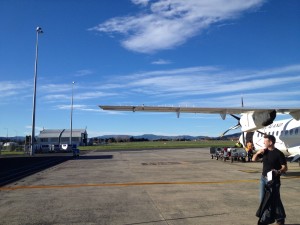 There is almost no trace of human habitation at the airport; some cows, a beautiful mountain off in the distance, and green grassland everywhere. It was 15 minutes or so into the drive into Dunedin before anything resembling urban life revealed itself. Dunedin proper is huge; almost the same area as Rhode Island. The setting of the central city is rather like Duluth; a harbor lying in a bowl of hills, with correspondingly steep streets. We were again lucky with the weather; although it was very windy, temperatures were at near-record highs and there was gorgeous blue sky all the time we were there. So I got some more walking in, including a visit to the Dunedin train station, a beautifully restored piece of high Victorian gingerbread.
There is almost no trace of human habitation at the airport; some cows, a beautiful mountain off in the distance, and green grassland everywhere. It was 15 minutes or so into the drive into Dunedin before anything resembling urban life revealed itself. Dunedin proper is huge; almost the same area as Rhode Island. The setting of the central city is rather like Duluth; a harbor lying in a bowl of hills, with correspondingly steep streets. We were again lucky with the weather; although it was very windy, temperatures were at near-record highs and there was gorgeous blue sky all the time we were there. So I got some more walking in, including a visit to the Dunedin train station, a beautifully restored piece of high Victorian gingerbread.
The hall was a larger version of the hall in Auckland, although the acoustics were not as good. (The organ, on the other hand, was absolutely massive.) After the concert, what seemed like most of the orchestra gathered at an Italian restaurant in a beautiful old dining room downtown in what looked like a long-standing orchestra tradition. There seemed to be a good deal of sorting at dinner, both by gender and by instrument. Naturally, I was with a bunch of lower-string guys. But everyone was having a good time, with lots of food and drink; it was fun to watch.
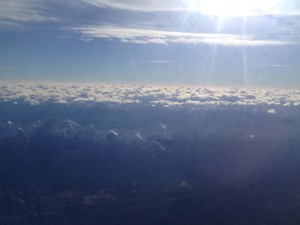 I was lucky enough to be on the later flight back to Wellington the next day; not only had I drunk too much the night before but the wind howled loudly all night, making sleep difficult. The flight back to Wellington promised to be interesting; the flight path went up almost the entire east coast of the South Island, and there a lot of wind at both airports. Unfortunately I didn’t have a window seat, but the gentleman who did offered to trade with me after we talked for a bit about his New Yorker (and no doubt after seeing my longing glances out the window). The flight attendant chastised us over the intercom when we exchanged seats, as I’d waited to say yes until just after take-off, but it was a very gentle chastising. I got some wonderful shots of the coast, even though increasingly distracted by the fact that my seat mate looked like Sam Neill. Of course it wasn’t; movie stars don’t travel on commuter flights, or allow themselves to be engaged by strangers in conversations about cross-wind landings and research on the sub-fornical gland. But he reminded so much like Sam Neill that, when we got off, I mentioned it to one of the musicians, who said “yes, that is Sam Neill.” “But why didn’t anyone say anything?” “O, we like to give him some privacy.”
I was lucky enough to be on the later flight back to Wellington the next day; not only had I drunk too much the night before but the wind howled loudly all night, making sleep difficult. The flight back to Wellington promised to be interesting; the flight path went up almost the entire east coast of the South Island, and there a lot of wind at both airports. Unfortunately I didn’t have a window seat, but the gentleman who did offered to trade with me after we talked for a bit about his New Yorker (and no doubt after seeing my longing glances out the window). The flight attendant chastised us over the intercom when we exchanged seats, as I’d waited to say yes until just after take-off, but it was a very gentle chastising. I got some wonderful shots of the coast, even though increasingly distracted by the fact that my seat mate looked like Sam Neill. Of course it wasn’t; movie stars don’t travel on commuter flights, or allow themselves to be engaged by strangers in conversations about cross-wind landings and research on the sub-fornical gland. But he reminded so much like Sam Neill that, when we got off, I mentioned it to one of the musicians, who said “yes, that is Sam Neill.” “But why didn’t anyone say anything?” “O, we like to give him some privacy.”
Sam Neill, of course, is a Kiwi, and grew up in Christchurch. He owns a winery and home not too far from Dunedin, and was apparently making a documentary in the South Island and was traveling with his crew back to Wellington, where he also has a home. So that’s why he was sitting next to me on a turboprop, bouncing into Wellington airport. And that’s how I not only met Sam Neill, but can testify that he is, from all appearances, a genuinely nice guy. Part of me wishes I had at least told him how much I enjoyed the many performances of his that I’ve seen, but I’m also glad I managed to “give him some privacy” as well.
We had returned to a Wellington suffering from more normal winter weather; very blustery (as this video of crosswind landings during a Wellington winter demonstrates) and quite wet. I took the commuter rail to Brian’s house that evening for dinner with Lyndsay Mountfort and his wife Emma. Lyndsay, another Kiwi, is one of the orchestra’s longest-serving members and had done extensive service on their orchestra committee. He had also developed, with violist Phillip Rose and former NZSO hornist Peter Sharman, an impressive web-based orchestra management package by the name of Impresario, which was in use by the NZSO as well as the Auckland Philharmonic and the Adelaide Symphony, so we had a lot to talk about on both fronts.
Sleeping was again difficult that night, due to being on the 7th floor of a lightly-constructed building in the middle of a howling gale (or, as the locals referred to it, “a moderate breeze with occasional showers”). It was still howling on Saturday, a day made more difficult by the fact that I couldn’t get wi-fi at the hotel (also due to the howling gale; reception improved enormously when the wind died down). But I did get out to a fish-and-chips place on Cuba Street that I’d wondered about, and looked around for gifts to bring home. I found a couple of CDs by local bands recommended for me by the orchestra’s resident heavy-metal expert, violist Jenaro Garita, to bring home to my son Sam. But I didn’t find the opossum beanie and scarf that I saw in the Cable Car Museum gift shop and had coveted for my wife Emily.
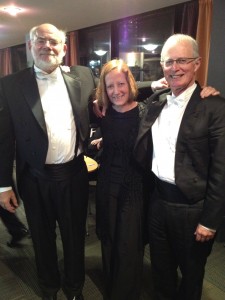 I went down to the hall to practice for a bit before the acoustic rehearsal that evening. It was rather odd to finally get to play the concert in the orchestra’s home venue, at least for me; I felt I was still on tour and dealing with unfamiliar acoustics. And the notion of an acoustic rehearsal in the orchestra’s home venue seemed a little odd as well, although, as a newbie, I was very grateful for it. But the concert went well and was, I believe, broadcast live on Radio New Zealand, under whose auspices the orchestra had played as the New Zealand Broadcasting Corporation Symphony Orchestra until 1989.
I went down to the hall to practice for a bit before the acoustic rehearsal that evening. It was rather odd to finally get to play the concert in the orchestra’s home venue, at least for me; I felt I was still on tour and dealing with unfamiliar acoustics. And the notion of an acoustic rehearsal in the orchestra’s home venue seemed a little odd as well, although, as a newbie, I was very grateful for it. But the concert went well and was, I believe, broadcast live on Radio New Zealand, under whose auspices the orchestra had played as the New Zealand Broadcasting Corporation Symphony Orchestra until 1989.
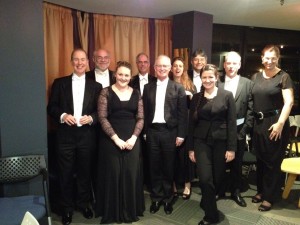 There was a lovely post-concert party in the Green Room afterwards, during which I said goodbye to the many orchestra members who had been so welcoming and helpful, and got some pictures with the viola section.
There was a lovely post-concert party in the Green Room afterwards, during which I said goodbye to the many orchestra members who had been so welcoming and helpful, and got some pictures with the viola section.
Sunday morning arrived minus the gale, so I was able to get wi-fi again. I did a little more shopping in the morning before meeting Brian for lunch and a final round of sightseeing (and gift-buying, including the opossum scarf and hat). We went to the Wellington City and Sea Museum, appropriately enough sited in an old customs building on the waterfront, as well as the nearby National Portrait Gallery. My flight to Auckland left in the late afternoon to connect to an evening flight to San Francisco. The flight home was on a rather tired Air New Zealand 747-400 (actually put out to pasture about two months later). Flying home from a wonderful adventure, I was rather more tired and grumpy than I should have been about the fact that I was trapped in my seat for much of the flight by the two very deep sleepers slouched between me and the aisle. But it was nice to get back to summer and to go sailing again while recovering from the jet lag – which, surprisingly enough, was not too bad in either direction, considering the distance.
About the orchestra
The New Zealand Symphony Orchestra is more-or-less officially the national orchestra of New Zealand, although not the only professional orchestra in the country. It gets about 75% of its funding – $NZ 13 million or so – as a direct grant from the national government, while the country’s other arts group get their government funding through the government arts board, Creative New Zealand. Base annual salary is around $NZ 70,000. I was not there nearly long enough to get a good sense of just how far that goes in Wellington. But the members of the orchestra seemed to be living lives of similar material comfort and middle-classitude to those of my colleagues in Milwaukee. I suspect that many of them are in two-income households, however (as are many American orchestra musicians, of course); the cost of housing and transportation in particular seemed higher to me than at home, and likely not easy to handle for a family on just one orchestral salary.
The orchestra works under a union-bargained collective agreement, although the union is not, as in the US, a stand-alone organization; rather it is “the Musicians’ Branch of the Service and Food Workers Union.” The relationship with a union that is only a small part musician seems not to be a problem; while I didn’t learn as much about the orchestra’s internal workings as I’d hoped (due entirely to my being busy enjoying other aspects of my trip), the orchestra appears to have an active and productive relationship with their management and as much autonomy and support as they need in negotiations and contract administration.
The management consists of 30 or so staffers, plus several “regional representatives” (who may be volunteers, however.) Inevitably, some in the orchestra believe the orchestra to be over-staffed, and of course the orchestra does not carry a big development department, which makes a comparison with American orchestra staffing levels a little unfair. It didn’t seem an unreasonable number to me, given the kind of traveling the orchestra does. And, as I mentioned above, those staffers I dealt with seemed quite good at their jobs. (It should be noted, especially in an online-only article about the NZSO, that it was the first orchestra in the world to have its own website, although the prime mover behind that development was former NZSO principal bass Dale Gold.)
The board, on the other hand, is tiny. Whether this is a legacy of the orchestra’s long history as a department of the New Zealand Broadcasting Corporation, or a quirk in local non-profit law, or something else entirely, is not something I asked or figured out during my visit. Certainly they don’t need to do as much fundraising as an American orchestra of the same budget size would, but boards do more than just raise money.
The orchestra’s work week is based, as far as I could determine, on the concept of hours rather than services. This meant that, during weeks the orchestra wasn’t traveling, quite a bit of rehearsal was allowed. During my first week there, we had eight rehearsals, three concerts, and two acoustic rehearsals, as well as travel to two different cities. But all the travel was on one day (Wellington to Hamilton to Auckland); and, as I mentioned earlier, traveling by air in New Zealand is about as painless as one could possibly wish. No doubt if I’d had to worry about child care, and mowing the lawn, and shopping for dinner, and getting my drivers license renewed during that week, the schedule would have felt heavier than it actually did to me.
Balancing things out was the following week’s schedule, which consisted of three concerts and associated acoustic rehearsals, with two nights spent on the road. I suspect this pattern of a heavy week followed by a light one happens quite often due to the nature of the orchestra’s subscription concert pattern.
Putting aside the issue of schedule, the orchestra’s working conditions and environment struck me as very good. The facilities at the Michael Fowler Center, the Wellington home venue, were lovely (although I understand parking could be an issue). There’s a large green room for the orchestra and a few practice rooms, as well as a lounge with kitchen facilities and a computer (with Internet access) and printer/copier provided by management. The green room overlooked the harbor, which made for some distraction at first – like most everything else in Wellington, the harbor was gorgeous. Access to backstage was by keycard, with no stage door security personnel to be officious, so it’s easy for orchestra members to get in and out whenever they wish. I used that access to practice, as the walls of my apartment were on the thin side.
Travel conditions were excellent as well; while the hotels were not all of the same quality, it seemed to me as if the orchestra was put in the best accommodations in whatever town they were visiting. In Auckland, that meant a very nice hotel indeed. And most of the orchestra’s travel was by air, which had an almost dream-like ease compared to the nasty and brutish conditions that Americans endure domestically, even though all the flights were short and many of Air New Zealand’s aircraft are quite old (much of the domestic fleet are Boeing 737-300s, only a handful of which remain in service in the US; I suspect the fuel efficiency of newer aircraft matters less on such short routes). Also nice was that transportation from home to Wellington airport was paid for by the orchestra for all musicians, whether in the form of parking or taxi vouchers. And the airport was all of 15 minutes from central Wellington by car or taxi. For many musicians, that could mean leaving home an hour or less before wheels up.
Roughly half of the 80+ current members of the NZSO are native New Zealanders (aka “Kiwis”), with slightly less than half the principal corps also Kiwis. I found it interesting that a majority of the very fine string section were New Zealanders (many having advanced training overseas as part of their Overseas Experience). The largest group amongst the ex-pats were, not surprisingly, those from English-speaking countries, with about half of those from the UK. The rest were fairly evenly divided between musicians from the former Warsaw bloc countries, China, and western Europe, with one musician from Costa Rica.
The rest of the orchestra had a higher proportion of Kiwis as principals, but fewer as section musicians. Also interesting was that almost all of the wind/brass/percussion players came from English-speaking countries.
The orchestra appeared to be composed entirely of nice people. While perhaps a little more reserved at first towards a guest principal than my orchestra would be, the musicians were uniformly helpful and friendly. It hardly needs saying that the violists in particular were a lovely group – intelligent, interesting, and devastatingly good-looking (as you can see in the picture above).
Overall, the NZSO reminded me a lot of what I like most about my own orchestra; very collegial while at the same time willing to work hard and cooperate with any conductor who looked to be able to make them sound good. The fact that it’s situated, like my orchestra, in a city with great sailing was an added bonus.
So how did the orchestra sound? I thought the orchestra sounded great. There were considerably more musicians on stage than the nominal 80+ members listed on the website; it was the first time I’d played in an 11-person viola section in about 2 years (and that only for my orchestra’s Carnegie Hall concert). In terms of overall quality, I thought it would fit comfortably into the upper half of the ranks of full-time American orchestras – which, given its roughly $NZ 17 million budget and the fact that we were playing unfamiliar works with a young guest conductor, is quite remarkable.
The citizens of New Zealand get a huge artistic bang for the NZ bucks that subsidize the NZSO. In return, the musicians of the NZSO experience a quality of life that is, in many ways, impossible for an orchestra musician to replicate in the US or most anywhere else.
As much as I enjoy working with my Milwaukee colleagues and living in Milwaukee, I envy the musicians of the NZSO.
(More pictures can be found here)

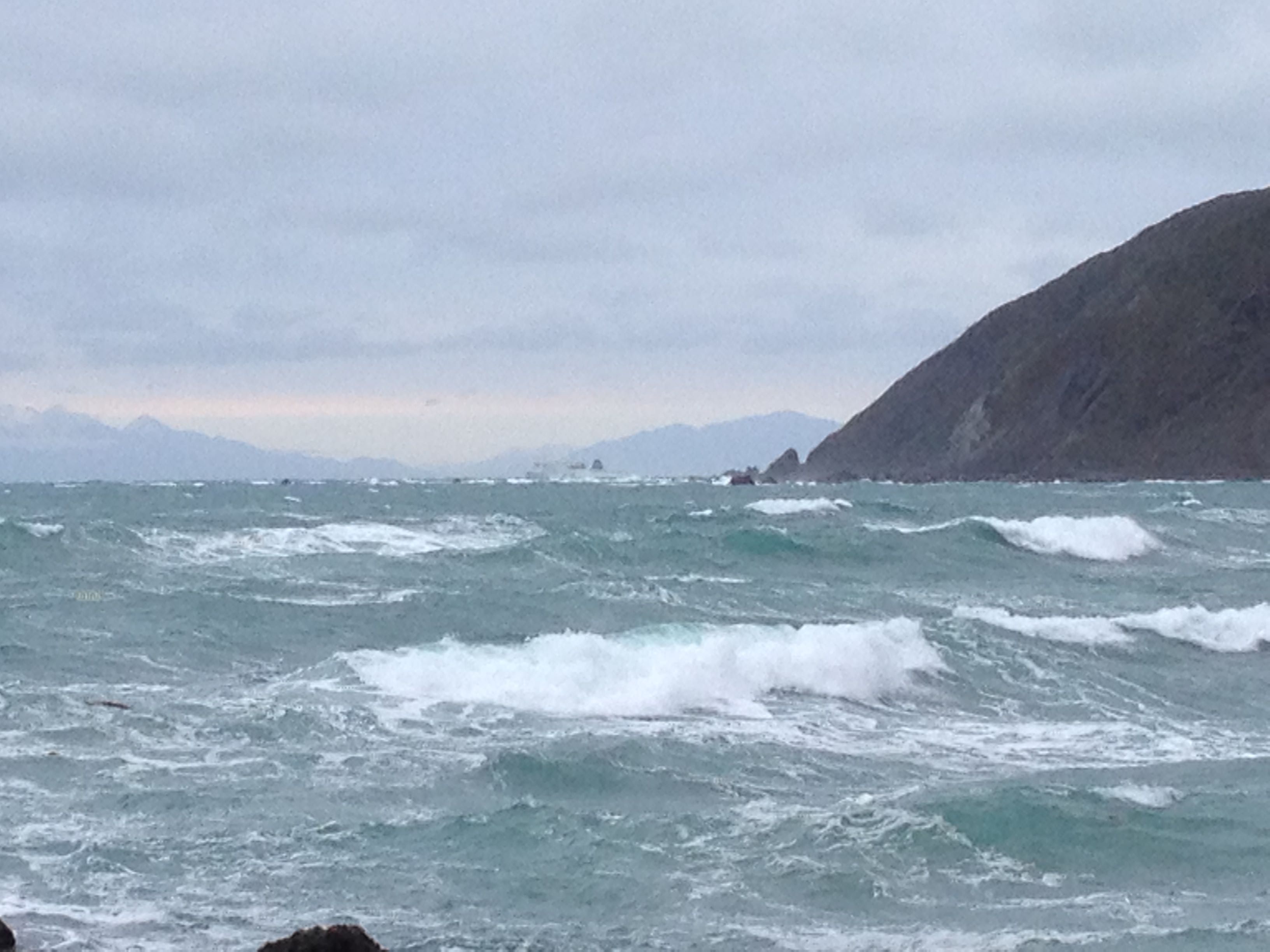
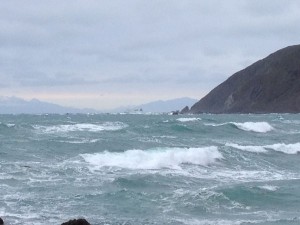
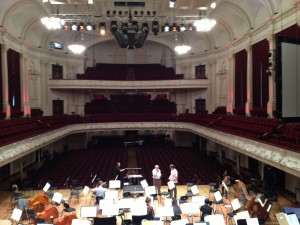
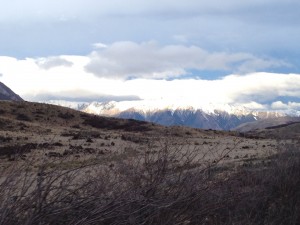
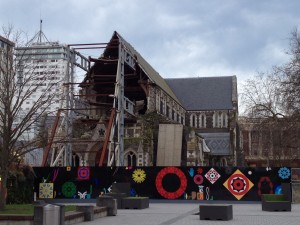
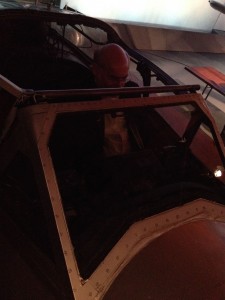
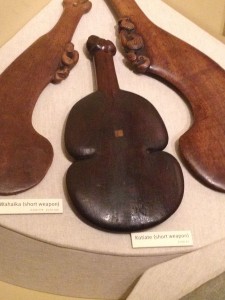
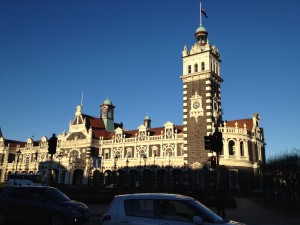
[…] Quite literally what I did for two weeks last summer. […]